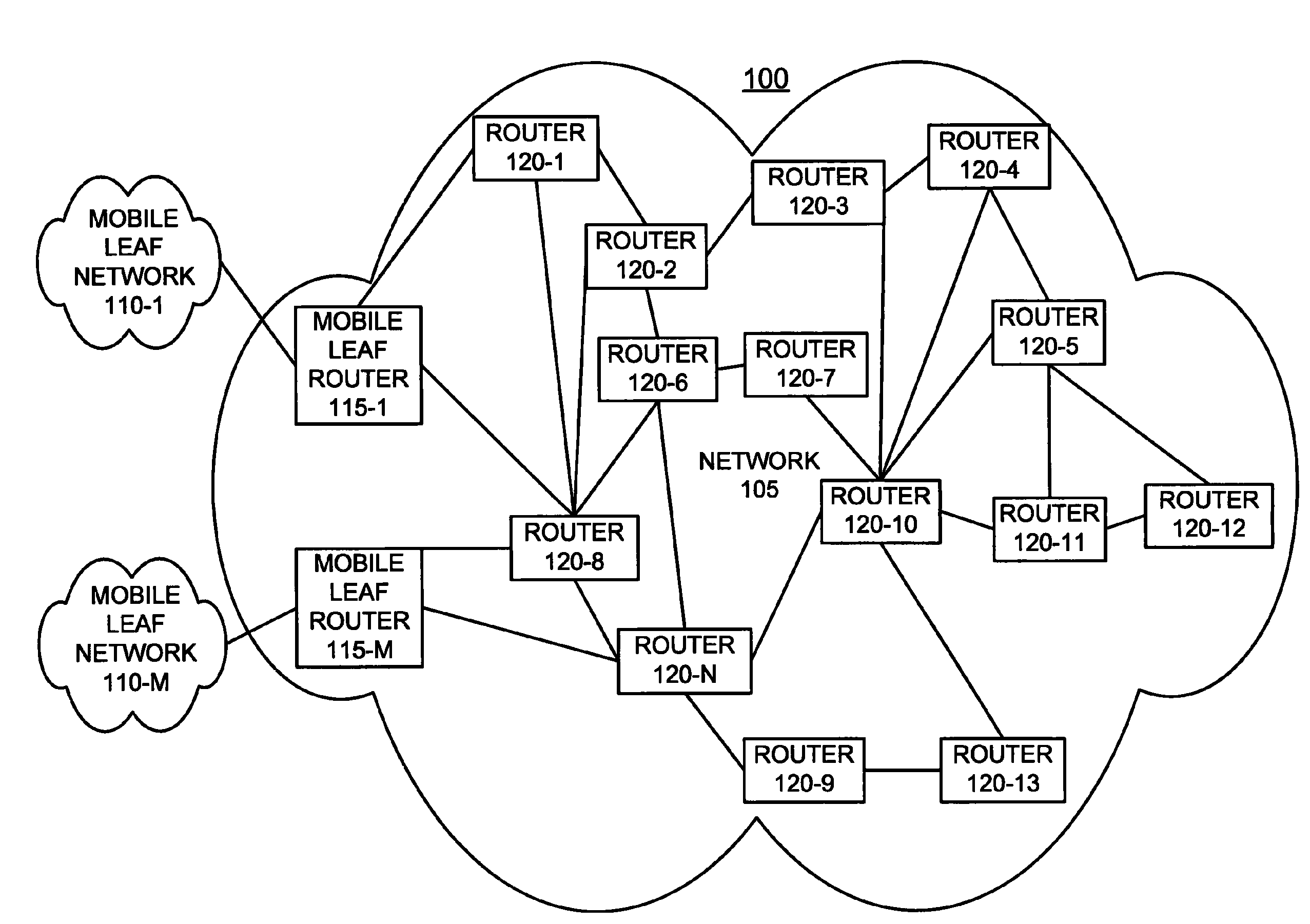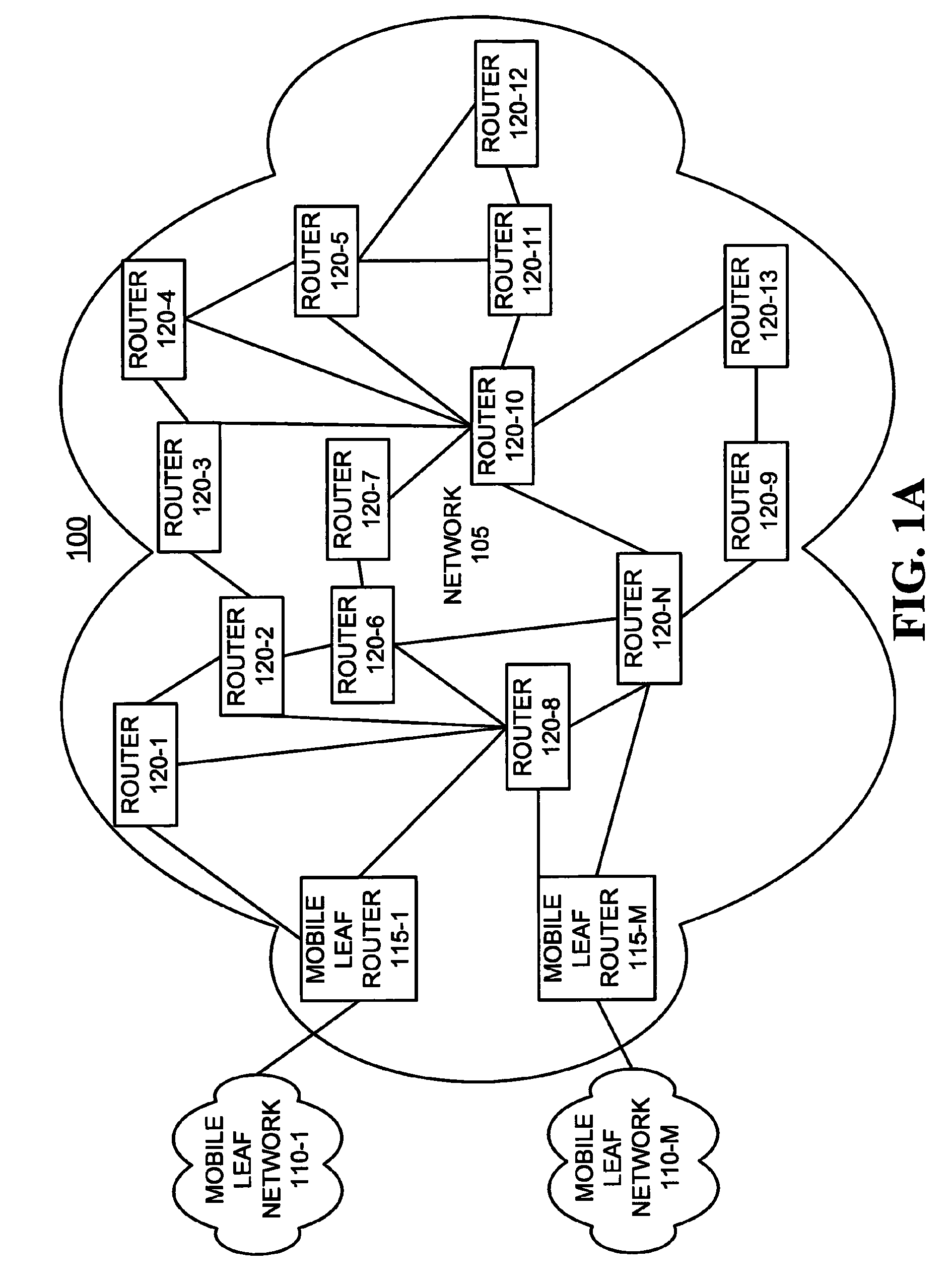[0011]Systems and methods consistent with the present invention address this need, and others, by modifying the basic OSPF
algorithm to optimize it for use over a multi-hop, multi-access
packet radio network while maintaining full compatibility with standard OSPF over other, adjacent networks, including wired networks. The modified OSPF
algorithm, consistent with the invention, resolves the scaling problems and other issues that may be encountered if standard OSPF is employed over a multi-hop, multi-access packet radio network with its own, private internal routing system. One optimization of the modified OSPF
algorithm is for routers belonging to the multi-hop, multi-access packet radio network to generate a virtual OSPF
network model for the purpose of
IP layer routing by OSPF that presents to OSPF routers an approximation of the true topology of the multi-hop, multi-
access network as known by its private routing system in a form that can be efficiently distributed by OSPF and processed by OSPF routers. This virtual model hides most effects of
intranet-layer mobility (i.e., changes in the
connectivity graph) while exposing enough information about the
intranet-layer topology to permit reasonable choices of entry and
exit point to and from the multi-hop, multi-access packet radio network, and, thereby, minimizes the OSPF routing overhead by minimizing the rate of routing updates. This virtual model also minimizes OSPF routing overhead by minimizing the size of OSPF
route advertisements and by minimizing the network degree of the virtual model.
[0012]In the virtual model, consistent with the present invention, a multi-hop, multi-access radio network may be represented as a set of multi-access links, with each being identified by its own designated
router. This representation has very low average network degree (only a little greater than 2) and, hence, minimizes the size of
route advertisements. Routers, consistent with the invention, may affiliate with the designated
router in the same OSPF area to which they are closest. Adjacent multi-access links may be connected by connecting routers that belong to both links and / or by point-to-point links between routers in each multi-access link. A
router belonging to a single multi-access link may be assumed to be able to communicate with every other router belonging to the same multi-access link at the same cost. The cost of routing a packet between routers belonging to different multi-access links may be the sum of the costs of the multi-access links traversed, and any connecting point-to-point links.
[0013]As an alternative to the above, each of the multi-access links just described may be replaced by a set of point-to-point links, arranged as a star with the router, that would have been the designated router of the multi-access link as its hub. Routers may affiliate with the hub router in the same OSPF area to which they are closest. Adjacent point-to-point
stars may be connected by connecting routers that belong to both stars and / or by additional point-to-point links between routers in each star. A router belonging to a
single star may be assumed to communicate with any other router belonging to the same star at a cost that is the sum of the costs of the point-to-point link from that router to the hub and from the hub to the second router. The cost of routing a packet between routers belonging to different stars may be the sum of the costs of the stars traversed, and any connecting point-to-point links. As will be appreciated, this representation is topologically almost equivalent to that of the preceeding
paragraph, differing only in the specific manner of its representation by OSPF link state advertisements. In particular, it shares with the aforesaid representation the property of minimizing the average network degree, and hence routing overhead.
[0018]In accordance with another aspect consistent with the principles of the invention, a method of reducing routing overhead on a network containing a sub-network consisting of a plurality of routers is provided. The method includes employing a public
routing protocol on the network and employing a separate, private
routing protocol internal to the sub-network. The method further includes acquiring information as to an internal topology of the sub-network and constructing a virtual model of the sub-network in terms of constructs comprehensible to the public, global
routing protocol. The method also includes employing the virtual model together with the sub-network's private, internal routing protocol for the purpose of routing within the sub-network and distributing the virtual model to other routers in the network for the purpose of routing in that network.
 Login to View More
Login to View More  Login to View More
Login to View More 


